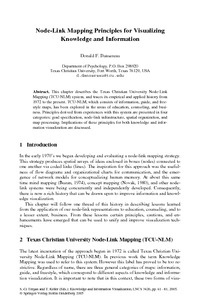Node-Link Mapping Principles for Visualizing Knowledge and InformationDonald F. Dansereau
Zu finden in: Knowledge and Information Visualization (Seite 61 bis 81), 2005
|
 |
 Diese Seite wurde seit 2 Jahren inhaltlich nicht mehr aktualisiert.
Unter Umständen ist sie nicht mehr aktuell.
Diese Seite wurde seit 2 Jahren inhaltlich nicht mehr aktualisiert.
Unter Umständen ist sie nicht mehr aktuell.
 Zusammenfassungen
Zusammenfassungen
 In his article on "node-link mapping principles for visualizing knowledge and information", Donald Dansereau describes the Texas Christian University Node-Link Mapping (TCU-NLM) system, and traces its empirical and applied history from 1972 to the present. The TCU approach is an extension of the traditional concept mapping approach aimed at visualizing knowledge. Concept maps are used to represent a person’s (a user’s/learner’s, or an expert’s) structure of ideas, thoughts, concepts, and content knowledge about a domain in a visual-spatial format.
In his article on "node-link mapping principles for visualizing knowledge and information", Donald Dansereau describes the Texas Christian University Node-Link Mapping (TCU-NLM) system, and traces its empirical and applied history from 1972 to the present. The TCU approach is an extension of the traditional concept mapping approach aimed at visualizing knowledge. Concept maps are used to represent a person’s (a user’s/learner’s, or an expert’s) structure of ideas, thoughts, concepts, and content knowledge about a domain in a visual-spatial format. This chapter describes the Texas Christian University Node-Link Mapping (TCU-NLM) system, and traces its empirical and applied history from 1972 to the present. TCU-NLM, which consists of information, guide, and freestyle maps, has been explored in the areas of education, counseling, and business. Principles derived from experiences with this system are presented in four categories: goal specification, node-link infrastructure, spatial organization, and map processing. Implications of these principles for both knowledge and information visualization are discussed.
This chapter describes the Texas Christian University Node-Link Mapping (TCU-NLM) system, and traces its empirical and applied history from 1972 to the present. TCU-NLM, which consists of information, guide, and freestyle maps, has been explored in the areas of education, counseling, and business. Principles derived from experiences with this system are presented in four categories: goal specification, node-link infrastructure, spatial organization, and map processing. Implications of these principles for both knowledge and information visualization are discussed. Bemerkungen
Bemerkungen
 Leider ist die ursprünglich im Biblionetz erfasste URL eines Volltextes seit mehr als sechs Monaten nicht mehr gültig (Fehlermeldung 404) und wurde deshalb gelöscht. Es ist mir nicht bekannt, ob das Dokument unter einer anderen Adresse noch frei auf dem Internet verfügbar ist.
Leider ist die ursprünglich im Biblionetz erfasste URL eines Volltextes seit mehr als sechs Monaten nicht mehr gültig (Fehlermeldung 404) und wurde deshalb gelöscht. Es ist mir nicht bekannt, ob das Dokument unter einer anderen Adresse noch frei auf dem Internet verfügbar ist. The terms "information visualization" and "knowledge visualization" in the TCU approach are used to discriminate different kinds of maps from the perspective of the users/learners. The term "information" refers to data, which are presented to the users’/learners’ as external stimuli, which have not yet been cognitively processed more deeply and integrated into the users’/learners’ knowledge structure. This meaning is different from the information visualization approach and its focus on the visualization of structures inherent in abstract data.
The terms "information visualization" and "knowledge visualization" in the TCU approach are used to discriminate different kinds of maps from the perspective of the users/learners. The term "information" refers to data, which are presented to the users’/learners’ as external stimuli, which have not yet been cognitively processed more deeply and integrated into the users’/learners’ knowledge structure. This meaning is different from the information visualization approach and its focus on the visualization of structures inherent in abstract data. Dieser Text erwähnt ...
Dieser Text erwähnt ...
 Personen KB IB clear | Donald F. Dansereau , A. M. O'Donnell | ||||||||||||||||||
 Aussagen KB IB clear | Freestyle maps fördern das Lernen | ||||||||||||||||||
 Begriffe KB IB clear | Aehnlichkeit, Das Gesetz der
, Concept MapConcept Map
, freestyle mapsfreestyle maps
,  Gestaltgesetze
, guide mapsguide maps
, information mapsinformation maps
, information visualizationinformation visualization
, knowledge visualizationknowledge visualization
, Gestaltgesetze
, guide mapsguide maps
, information mapsinformation maps
, information visualizationinformation visualization
, knowledge visualizationknowledge visualization
,  Lernen Lernen learning
, learning
,  Mind Map Mind Map Mind Map Mind Map
| ||||||||||||||||||
 Texte |
|
 Dieser Text erwähnt vermutlich nicht ...
Dieser Text erwähnt vermutlich nicht ... 
 Nicht erwähnte Begriffe | Concept Mapping Software, Figur und Grund, Geschlossenheit, Das Gesetz der, Gestaltpsychologie, Mappingverfahren |
 Tagcloud
Tagcloud
 Zitationsgraph
Zitationsgraph
 Zitationsgraph (Beta-Test mit vis.js)
Zitationsgraph (Beta-Test mit vis.js)
 1 Erwähnungen
1 Erwähnungen 
- Interaktive Maps - Zugriffsinstrumente auf große Textmengen (Raja Gumienny) (2007)


 Anderswo finden
Anderswo finden
 Volltext dieses Dokuments
Volltext dieses Dokuments
 | Node-Link Mapping Principles for Visualizing Knowledge and Information: Artikel als Volltext bei Springerlink ( : :  , 204 kByte) , 204 kByte) |
 Anderswo suchen
Anderswo suchen 
 Beat und dieser Text
Beat und dieser Text
Beat war Co-Leiter des ICT-Kompetenzzentrums TOP während er Dieser Text ins Biblionetz aufgenommen hat. Die bisher letzte Bearbeitung erfolgte während seiner Zeit am Institut für Medien und Schule. Beat besitzt kein physisches, aber ein digitales Exemplar. (das er aber aus Urheberrechtsgründen nicht einfach weitergeben darf). Es gibt bisher nur wenige Objekte im Biblionetz, die dieses Werk zitieren.








 Biblionetz-History
Biblionetz-History